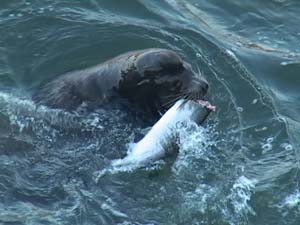forum
library
tutorial
contact

Snaking a Path to Protect Species
by Editorial BoardThe Oregonian, March 17, 2012
|
the film forum library tutorial contact |

|
Snaking a Path to Protect Speciesby Editorial BoardThe Oregonian, March 17, 2012 |
 Start with the easy one: Giant Burmese pythons are wreaking havoc in the Florida Everglades, sweeping the marsh clean of raccoons, opossums and white-tailed deer. Should the snakes be controlled, killed off? Of course. The pythons ravaging the Everglades started as pets tossed out by their owners. They don't belong there.
Start with the easy one: Giant Burmese pythons are wreaking havoc in the Florida Everglades, sweeping the marsh clean of raccoons, opossums and white-tailed deer. Should the snakes be controlled, killed off? Of course. The pythons ravaging the Everglades started as pets tossed out by their owners. They don't belong there.
But it quickly gets more complicated: Barred owls are steadily overwhelming endangered northern spotted owls throughout much of the spotted owls' dwindling range in Northwest old-growth forests. Should barred owls be shot to help spotted owls? Well, yes. But how many? Where? And for how long?
And it gets still harder: California sea lions have learned that a feast of endangered salmon and steelhead awaits them at Bonneville Dam on the Columbia River. In 2010, the hungry lions swam up the river and ate about 6,000 salmon, as much as 4 percent of returning adult salmon at the dam. Unlike fishermen, sea lions don't distinguish between endangered wild salmon and hatchery fish. Kill some of them?
Well, yes. But surely not 92 sea lions annually through 2016, the number which the National Oceanic and Atmospheric Administration authorized last Thursday. It's seems inconceivable that authorities would think it appropriate to kill hundreds of sea lions. After all, the much smaller recent removals -- 38 sea lions trapped and removed since 2008 -- seem to have had some effect. Biologists estimate that the sea mammals that congregated at Bonneville last year ate about 3,600 salmon.
What's the alternative? Rubber bullets, firecrackers, gates and fences have not deterred the sea lions. The Humane Society of the United States and others argue that it's wrong to kill sea lions while allowing commercial and sport fishermen to take many more salmon. Whatever you think of that argument, there is this reality: The federal government, the states and tribes are not going to shut down fishing and just leave Northwest salmon to the lions.
You hear other voices arguing that nature should be allowed to take its course. Evolution, you know, survival of the fittest.
You mean those descendants of pet snakes slithering through the Everglades? Those federally protected sea lions gathering at the foot of a major hydroelectric dam?
Then how do you feel about coyotes in central Washington preying on the last remaining pygmy rabbits? The government has paid hunters to control the coyotes and save the rabbits. Is that right or wrong?
Of course, it's not clear whether any of these wildlife "balancing" efforts ultimately can be successful over the long term. The barred owls are stronger, more aggressive and likely to outcompete spotted owls in any future contest for habitat. And good luck keeping the coyotes off those pygmy rabbits.
Still, it makes sense to intervene when the survival of a dwindling species is threatened by another animal, especially when the number of predators has rapidly expanded, as is the case with coyotes, barred owls and, yes, California sea lions. No one knows if the controls will work; the lions may keep coming upriver until it is obvious that killing them is not the answer. We'll say this: If sea lion controls don't reduce salmon predation, then the controls ought to be stopped.
Sea lions aren't pythons.
Related Sites:
NOAA Authorizes States To Remove Sea Lions That Threaten Protected Salmon ENews Park Forest, 3/15/12
Related Pages:
Not Many Sea Lions, But Two 'Individually Identifiable' Salmon Eaters Trapped, Killed by Staff, Columbia Basin Bulletin, 4/6/12
www.bluefish.org / ecologic / predation / sea lions
learn more on topics covered in the film
see the video
read the script
learn the songs
discussion forum
